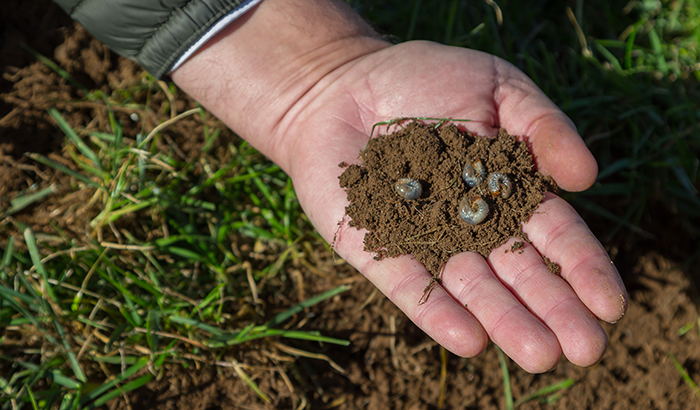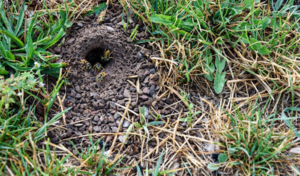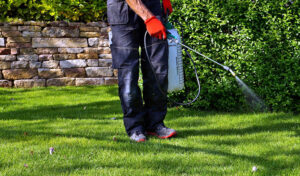Maintaining a beautiful lawn is a challenging task that takes time and effort, and finding grubs in your lawn can be one of the biggest obstacles.
Grubs are the larvae of beetles and they feed on the roots of grass causing brown patches and other damage to your yard. The good news is that with the right approach, you can treat your lawn for grubs effectively, keeping your grass healthy and green.
Today, we’re covering everything you need to know about grubs, including the best methods for lawn grub treatment. Continue reading to learn more!
Identifying Grubs
The first step to treating grubs in your lawn is identifying them. Grubs are small, white, C-shaped larvae that live in the soil beneath your yard. They feed on the roots of grass and can cause extensive damage if left untreated.
Here are some more signs to look for if you suspect grubs are the source of your lawn problems:
- Brown patches: Grubs feed on the roots of grass, causing the grass to wilt and turn brown. If grubs are present, you might notice brown patches or dead areas in your lawn, especially during the summer and fall when grubs are most active.
- Soft or spongy turf: As grubs feed on the roots of grass, they can cause the turf to become soft and spongy to the touch. If your lawn feels sponge-like, it might be a sign of grubs.
- Irregular patches of dead grass: Grubs feed on grass roots in patches, which can cause patches of dead grass to appear across your yard.
- Increased bird activity: Grubs are a source of food for many birds. If you notice an increase in bird activity on your lawn, it could be a sign they are feeding on grubs.
- Grass that easily pulls up: Grubs can cause your grass to become loose in the soil, making it easier to pull up by hand. If you notice that your grass is coming up easily, grubs might be the culprit.
If you notice any of these signs on your lawn, take action to prevent further damage. Lawn grub treatment in the late summer or early fall is the best time to prevent damage. You should make grub prevention part of your lawn care routine to keep your yard healthy and thriving.
The Best Time to Treat Grubs
Timing is critical when it comes to treating grubs. The best time to treat your lawn for grubs is in the late summer or early fall when the grubs are small and actively feeding on roots. Treating your lawn during this time can help prevent future damage to your lawn and keep it healthy year-round.
Treating your lawn for grubs in the spring or early summer is not recommended, as the grubs aren’t actively feeding at this time. Instead, they’re focused on growing and developing into adult beetles. Treating your lawn during this time is less effective since the grubs are not feeding on the roots of grass.
Types of Grub Control
There are two main types of grub control: chemical and biological. Chemical grub control involves the use of insecticides to kill grubs, while biological control involves using natural predators to control grub populations.
1. Chemical Grub Control
Chemical grub control is the most common type of lawn grub treatment. This involves the use of insecticides specifically designed to kill grubs. These insecticides come in different forms, including granules and liquids, and are applied to the lawn using a spreader or sprayer. Look for the following active ingredients: imidacloprid, chlorantraniliprole, or carbaryl.
One of the most popular insecticides for grub control is imidacloprid, which is sold under a variety of brand names. Imidacloprid works by targeting the nervous system of the grubs, causing them to die within a few days of application.
When using chemical grub control, you must follow the manufacturer’s instructions carefully. Always wear protective gloves and clothing when handling any chemical grub control products. Apply the insecticide evenly across your lawn, making sure to cover all areas. Also, be sure to water your lawn after applying the insecticide to help it penetrate the soil and reach the grubs.
2. Biological Grub Control
Biological grub control involves using natural predators to control grub populations. One of the most effective natural predators of grubs is a microscopic worm called Heterorhabditis bacteriophora. These worms are sold under a variety of brand names and can be applied to your lawn using a sprayer.
Biological grub control treatments work by infecting and killing grubs. When applied to your lawn, the worms enter the soil and release bacteria that infect the grubs, causing them to die within a few days. Since it doesn’t involve the use of harmful chemicals, this method of grub control is effective and environmentally friendly.
While biological grub control can be effective at controlling grubs, it isn’t always as fast-acting as chemical control options. This requires a certain amount of time to seek out and infect the grubs and may not provide immediate control of heavy grub infestations. It also might not be as effective in areas with sandy soils or in regions with high temperatures or dry conditions.
To maximize the effectiveness of biological grub control, it’s important to combine it with other integrated pest management strategies, like chemical controls. These methods will work hand-in-hand to mitigate the grubs and keep your lawn healthy.
Preventative Measures
Prevention is a key part of all lawn care plans. There are several preventative measures you can take to help prevent grub damage. One of the best ways to prevent grubs is to maintain a healthy lawn. This means mowing your grass regularly, watering it deeply but infrequently, and fertilizing it as needed.
You can also make your lawn less attractive to beetles by removing any debris that might accumulate on your lawn. Beetles are attracted to moist, cool areas, so make sure your lawn is well-drained as well.
Let Summit Lawn and Pest Control Help
With Summit Lawn & Pest Control, getting rid of grubs in your lawn has never been easier. We have a passion for providing fast and affordable home lawn care and pest control services so you can focus on enjoying your yard instead of worrying about nasty grubs.
Reach out today to schedule your free assessment! We serve Lehi, Orem, Provo, Spanish Fork, and other cities in Utah County, Utah.







